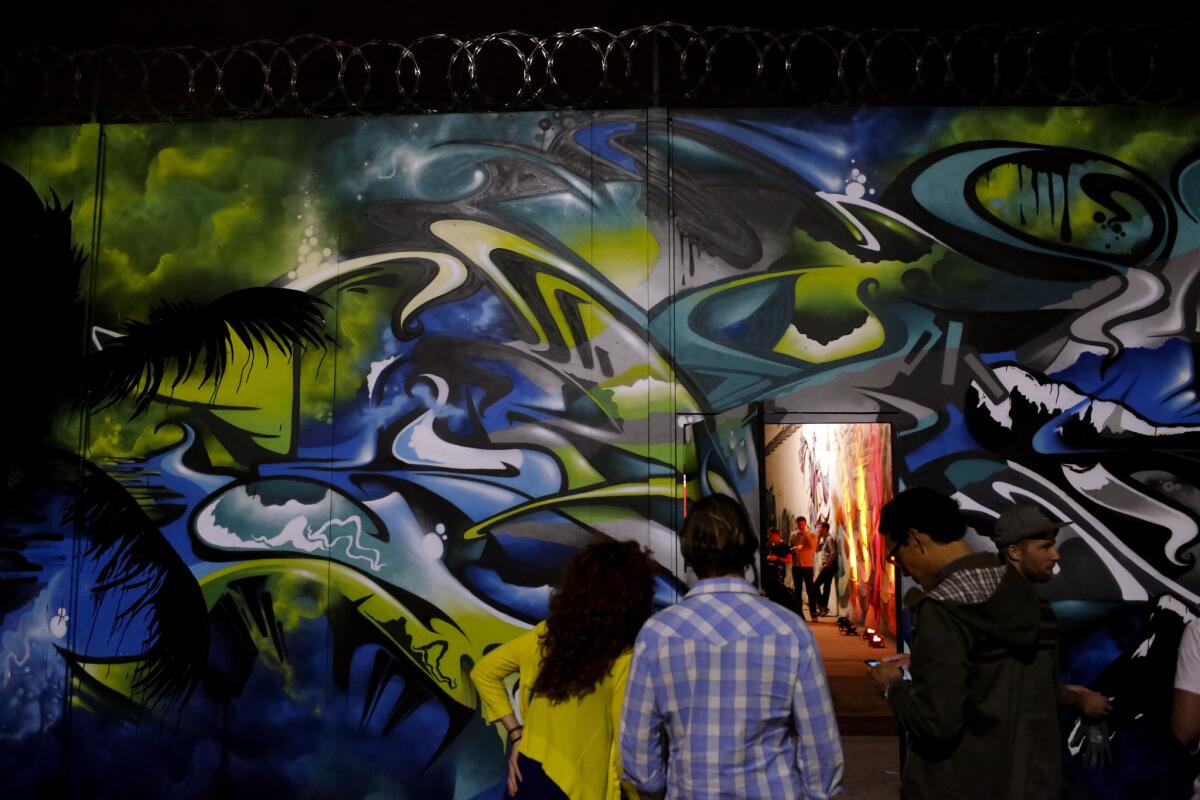Google Cultural Institute database wants to give street art permanence

- Share via
L.A. artist Kent Twitchell labored over his mural “Ed Ruscha Monument,” a six-story-high ode to the contemporary artist, for years — from 1978 to 1987. It presided over Hill Street near Olympic Boulevard in downtown L.A. for almost two decades until the federal government, which was rehabbing the building, painted over the artwork. The wall is now bare, a swath of clean white.
A new worldwide database of public art aims to preserve — if only in digital form — street art, a medium that is often political, sometimes renegade and, perhaps most important, frequently fleeting. These are artworks that may get tagged by graffiti or fall into decay because of weather exposure. The accessible, populist nature of the medium — buildings and sidewalks as canvases — also is what makes them vulnerable.
Scores of memorable works by well-known artists no longer exist: Victor Henderson’s Venice mural “Brooks Avenue Painting,” created with the late Terry Schoonhoven in 1969, was water-blasted in 2013 by the building owner. Frank Romero’s 1984 “Going to the Olympics” mural, on the 101 Freeway, was painted over by the city of L.A. in 2007 in what actually was an effort to preserve the decaying work. (The Mural Conservancy of Los Angeles has since removed the paint and restored the art.) Last summer, the indie band Foster the People saw its mural removed from a downtown building over a permission dispute.
“You never know when a mural will be scrubbed out or painted over,” said Lucy Schwartz, program manager for the Google Cultural Institute, the umbrella organization that this week launched an expanded version of its searchable database of photos simply called Street Art. “Our goal is to offer a permanent home for these works so users today and tomorrow can enjoy them and learn about them.”
Among the pieces in the online collection: Twitchell’s Ruscha mural.
“It’s very exciting,” Twitchell said. “There will never be anything like the original. But where thousands of people may have seen that mural, now millions will see it — even though it’s gone. It’s a beautiful irony.”
The project launched in June 2014 with 5,000 images and 31 partnering organizations internationally. This week Google added 55 partners who have helped to document more than 5,000 more pieces of public art, all viewable at streetart.withgoogle.com/en/. The collection includes Australia, Sweden, Colombia, South Africa —34 countries in all. It also includes mobile apps and listening tours, as well as a map on which visitors can click to browse local art.
Schwartz made the rounds at a lavish relaunch party Tuesday night in Los Angeles. Wearing a smartwatch with a face featuring murals that changed every hour, the tech exec mingled with street artists, emerging and established, at the Container Yard, a downtown arts district event space and popular hangout for graffiti artists.
About 450 people crowded into the former mochi factory, including artists Tristan Eaton, Levi Ponce, Random Act and Mear One. As the DJ spun a mix of soul, pop and house music, guests moved among about half a dozen exhibitions featuring technology used in the project.
There was the Gigapixel Art Camera used for high-resolution detail photography, the Liquid Galaxy screen featuring satellite imagery of street art around the world and an employee wandering around with a 45-pound, robotic-looking Street View Trekker strapped to her back.
The central art exhibit at the party was an “interactive, experiential, sculptural installation” by the street art collective Cyrcle, made up of David Leavitt and David Torres. The plywood booth, in the shape of a hexagon, has black-and-white Jesus imagery on the outside and a padded, soundproofed room on the inside. Guests were encouraged to reveal their sins or deepest convictions, privately, into a microphone. An audio-manipulated visualizer translated their words into landscape-like imagery that appeared on a large screen outside the booth.
“I think a lot of the times when I am creating or making something, the overarching thought in my mind is, ‘What can I say or what can I do that will outlive me?’” Torres said. “Technology is now what carries history.”
Despite the enthusiastic reception the project received, some artists worried that the Google database was another example of a corporate giant attempting to capitalize on street art.
L.A. muralist Willie Herrón III said Google asked him, through the Mural Conservancy of Los Angeles, to contribute images of his work to the Street Art initiative. He declined.
“I kind of shy away from being a part of anything that’s corporate because I feel they sort of jump on our talent as artists for their own benefit,” Herron said. “I’m kind of paranoid about public domain and fair-use issues. I’m not opposed to what Google’s doing, but I want to see how it does first, test the grounds, play it safe.”
Oakland-based street artist Eddie Colla, who has public artworks in Bangkok, Thailand, and in Paris, also was wary of the Google project.
“Is Google doing this out of sheer art appreciation? Maybe,” Colla said. “I don’t think they became the company they are because they’re not business savvy. My guess is there’s some angle on this to become the dominant site or portal that presents street art. There’s probably a monetary motive behind it.”
More than 80 organizations have decided to join the project. In Southern California, the list includes the Mural Conservancy, the Wende Museum in Culver City, the Pasadena Museum of California Art and the community revitalization group Coachella Walls. Artist Andrea LaHue and the Gabba Gallery of L.A. formed the organization StreetArt Brokerage Firm, which also is a partner in the Google initiative.
“Street art is trying to elevate itself to a higher art form, and Google is allowing us to,” said LaHue, who paints under the name Random Act. “It brings credibility.”
Street art may be known for its anti-establishment bent, but corporate involvement is far from new. Paint companies and clothing brands have long sponsored high-profile street artists, hoping to piggyback on artists’ perceived hipness or to get their products captured in Facebook and Instagram shots. Downtown L.A.’s arts district, thick with public art murals, has become a popular location for shooting print ads and TV commercials.
L.A. artist and street art documentarian John Carr, who produced the 2012 “Voice of Art” series for Pharrell Williams’ YouTube channel, said the growing popularity of street art comes with concerns about how the works are showcased online.
“There’s so much online coverage on blogs, Facebook, Instagram,” Carr said. “If Google’s providing one more platform, that’s probably a great thing. But when it comes to photography and online, copyrights — crediting the artists — are important. That’s where you have to be careful.”
Google has said the street art in its online project cannot be downloaded, and the company credits all featured artists. Images in Street Art also include the title of the mural and the date it was created.
Some of the online exhibits include quotes from the artists. Others have audio commentary. One tab is dedicated to artist stories.
On Tuesday night, sipping cocktails in the party courtyard near a liquid nitrogen ice cream truck, longtime L.A. muralists including Victor Henderson, John Wehrle, Richard Wyatt Jr. and East Los Streetscapers members David Botello and Wayne Healey said they supported Google’s efforts to preserve street art.
“It removes them and takes them out of context and time; but it’s also a way to share them around the world,” Henderson said.
Added Isabel Rojas-Williams, the Mural Conservancy’s executive director: “We can’t physically restore all the murals in the world, so this project is a great way to preserve our history.”
In an interview this week, street artist Thierry Guetta, also known as Mr. Brainwash, agreed.
“You do a wall that’s illegal, someone gets a photo, three days later it’s gone forever,” he said. “They are giving the art life forever.”
For more arts and entertainment stories, follow us: @debvankin and @saba_h
More to Read
The biggest entertainment stories
Get our big stories about Hollywood, film, television, music, arts, culture and more right in your inbox as soon as they publish.
You may occasionally receive promotional content from the Los Angeles Times.












